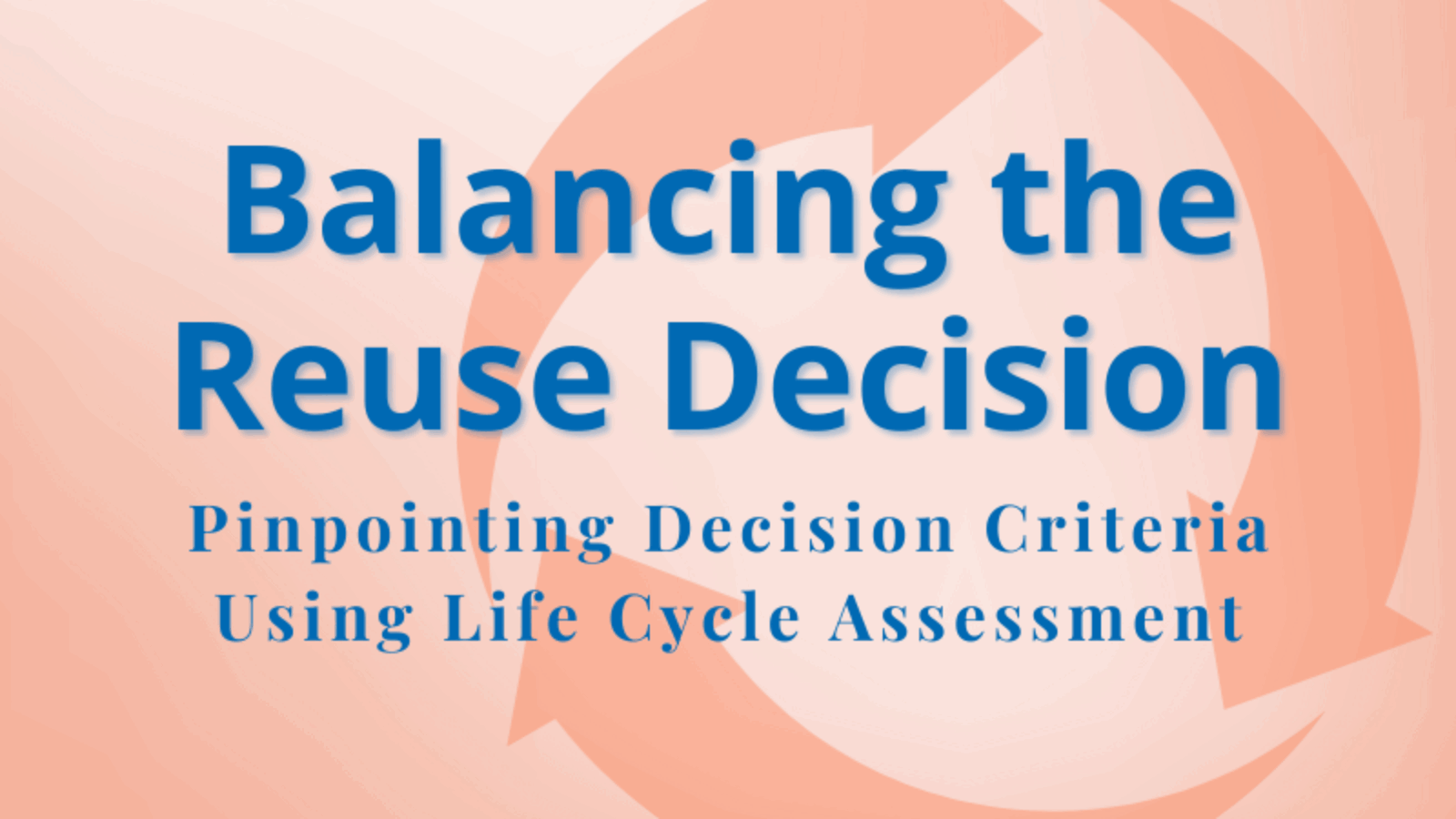Reusable packaging seems like the ideal solution for a more circular economy, but without data, it’s difficult to know for sure. To fully understand the impacts of an entire reuse system, conducting a Life Cycle Assessment (LCA) is essential. LCA is a standardized and reliable method for calculating environmental impacts, taking into account every stage of a package’s life cycle. It is a powerful tool for evaluating packaging decisions, particularly in complex reuse scenarios. LCAs help to quantify environmental trade-offs, revealing the full picture beyond just carbon impacts.
Why Use LCA for Reusable Packaging?
Utilizing a Life Cycle Assessment (LCA) to evaluate a reusable packaging system offers many benefits, especially when weighing the trade-offs involved in material selection, environmental impact, and regulatory compliance.
Material selection is often the most significant contributor to a product’s overall environmental footprint. When designing a reuse system, it is important to choose materials that are both durable and have a relatively low environmental impact. LCA enables you to compare different material options and identify the one that best aligns with your sustainability goals.
LCA can also help ensure regulatory compliance across different regions. For example, in the United States, several states have implemented bans on single-use plastics. By running LCA comparisons, you can make informed decisions that align with evolving regulations both domestically and internationally.
Another advantage of LCA is its ability to assess multiple environmental indicators, not just carbon emissions. Depending on your company’s priorities, metrics such as water usage, human health impacts, or fossil fuel consumption may be equally important. LCA provides a comprehensive view to help you make balanced, data-driven decisions.
Beyond environmental impacts, LCA can also uncover key economic and social considerations. For instance, reusable packaging systems may require higher upfront investment for more durable materials or new infrastructure. LCA can also factor in real-world elements such as damage rates, consumer behavior, and access to recycling. These factors are critical to understanding the potential benefits and challenges of a reuse system.
Variables That Matter in Reuse Scenarios
Rethinking the Role of Transportation in Reuse Systems
Transportation can play a role in packaging LCAs, depending on variables such as the mode of transport and the distance traveled. In reuse systems, reverse logistics are often needed to return packaging for washing, which can take place either in-house or at a third-party facility.
When third-party washing facilities are used, transportation is typically required. For reusable primary packaging used directly by consumers, this transport is often local or regional. In contrast, B2B reusable packaging systems often involve cross-country or international transportation. As a result, the environmental impact of return transportation in most reuse systems tends to be relatively minor, especially when the additional distance traveled is small and remains local or regional.
Damage Rate & Customer Return Rate
While transportation may have a relatively minor impact, the damage rate and customer return rate can significantly affect the overall environmental performance of a reusable packaging system. These factors directly influence the Effective Use Rate, which accounts for the cumulative probability of each package returning to circulation multiple times.
The Effective Use Rate provides a more realistic estimate of how often a reusable package is actually used, on average, under real-world conditions. It is calculated using a combination of the Package Use Rate, Net Return Rate, and Loss Rate. A low Effective Use Rate can lead to higher environmental impacts, especially when many units are damaged or not returned.
Understanding these rates is especially important when identifying the breakeven point, which refers to the point where the environmental impacts of a reusable system become lower than those of a comparable single-use option. To reach and maintain this breakeven point, it is important to minimize damage and ensure a high customer return rate.
The Role of Washing Cycles in Reusable Packaging Systems
Washing cycles are an important factor to consider when evaluating the environmental impact of reusable packaging systems. While not every system requires washing, such as reusable pallets which are typically not cleaned between reuse cycles, others, especially in the food and beverage industry, rely heavily on washing for proper sanitization between uses.
Each wash involves the use of water, energy, and cleaning agents. Even though detergents are often used in small quantities, their environmental impact can be significant if they contain toxic ingredients. These substances can affect a wide range of environmental indicators, from water quality to human health.
In addition to chemicals, water and energy use also play a major role. The cumulative impact of repeated wash cycles can add up, particularly in systems with short turnaround times or high reuse rates.
This is why it is essential to evaluate all aspects of the washing process, including detergent composition, water and energy use, and the specific requirements of the packaging system, when determining the most sustainable approach.
Using Sensitivity Analysis to Make Better Reuse Decisions
When conducting a comparative Life Cycle Assessment (LCA) between a single-use package and a reusable system, sensitivity analysis can help guide holistic and informed sustainability decisions. Implementing a reusable system is not only an investment, it also requires careful planning to ensure all elements work together efficiently. That’s where LCA proves invaluable. It allows you to test different variables and build a realistic yet ideal system before committing to infrastructure or operational changes.
Let’s take a look at a simple reuse example involving a reusable beverage cup and lid. To identify the ideal reuse system for this packaging, we’ll test a few key sensitivity inputs: two different washing cycles, transportation distance, damage rate, and customer return rate. All testing was performed using Trayak’s EcoImpact COMPASS Life Cycle Assessment software.
Washing Cycle Sensitivity Analysis
In this scenario, we simulated switching from a Standard Commercial Dishwasher Cycle to a High Efficiency Eco Cycle. Both cycles wash the same number of cups, but the high efficiency cycle uses less water, electricity, and detergent.
| Inputs | Standard Commercial Cycle | High Efficiency Eco Cycle | GWP Impacts | Water Impacts |
| Washing Cycle | Water Usage: 2.5 liters per cycle Electricity Usage: 0.5 kWh per cycle Detergent Usage: 0.015 kg per cycle Cups Washed per Cycle: 20 cups |
Water Usage: 1.8 liters per cycle Electricity Usage: 0.3 kWh per cycle Detergent Usage: 0.012 kg per cycle Cups Washed per Cycle: 20 cups |
-10% | -17.13% |
This analysis highlights how even small improvements in washing cycles can lead to meaningful environmental benefits.
Damage Rate Sensitivity Analysis
Next, we assess improving the damage rate from the starting rate of 10% to the improved rate of 6%. This seemingly small change results in nearly a 40 percent reduction in both GWP and water impacts.
| Input | Starting Damage Rate | Improved Damage Rate | GWP Impacts | Water Impacts |
| Damage Rate | 10% | 6% | -39.94% | -39.99% |
This shows the importance of designing durable products and minimizing breakage or loss in reuse systems.
Customer Return Rate Sensitivity Analysis
The next comparison looks at a customer return rate of 70 percent compared to a higher rate of 85 percent. Increasing the return rate led to a 17 percent reduction in both greenhouse gas emissions (GWP) and water impacts.
| Input | Starting Return Rate | Improved Return Rate | GWP Impacts | Water Impacts |
| Return Rate | 70% | 75% | -16.67% | -16.67% |
This demonstrates how important consumer participation is in making reuse systems successful.
Return Logistics Transportation Sensitivity Analysis
The final sensitivity analysis compared two transportation distances for return logistics. The first option used a distance of 150 miles, while the second option assumed only 15 miles. The results showed a small reduction of 2.9 percent for GWP and 0.39 percent for water impacts, making the overall effect relatively minimal.
| Input | Starting Transportation Distance | Improved Transportation Distance | GWP Impacts | Water Impacts |
| Return Logistics Transportation | 150 km | 15 km | -2.9% | -0.389% |
This suggests that while transportation matters, other factors such as return rate and durability tend to have a larger influence on overall environmental impact.
Real-World Examples: LCAs Uncover Unexpected Wins
Running multiple LCA comparisons helped us identify which variables had the most significant impact in our reusable packaging scenario. Without data to support decision-making, it’s difficult to know which levers truly matter. For example, a company might focus on improving return logistics by locating closer washing facilities to reduce transportation distance. However, transportation often has a relatively small impact compared to other factors.
Our analysis showed that return rate and damage rate tend to drive the largest environmental improvements. This means that, when designing a new system or making improvements to an existing one, focusing on packaging durability and strategies to encourage customer returns is essential for long-term success.
Making Informed Reuse Decisions with Trayak
Designing or optimizing a reusable packaging system involves many moving parts, and it can be difficult to know which decisions will truly make a difference. As this analysis shows, some of the most impactful variables, such as damage rate and return rate, may not be immediately obvious. Life Cycle Assessment (LCA) helps uncover these hidden tradeoffs by providing a data-driven, system-level view of environmental performance. With Trayak’s EcoImpact COMPASS LCA software, companies can test different scenarios, identify the most influential factors, and confidently invest in strategies that lead to real sustainability gains. Whether you are starting from scratch or improving an existing system, LCA ensures you are making informed decisions based on evidence, not assumptions.

